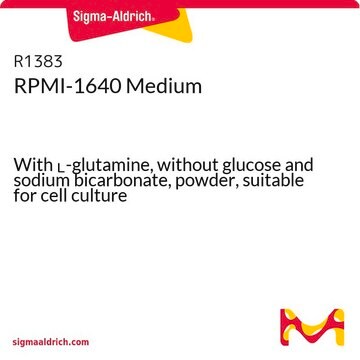R6504
RPMI-1640 Medium
With L-glutamine, without sodium bicarbonate, powder, suitable for cell culture
Synonym(s):
Roswell Park Memorial Institute 1640 medium
Sign Into View Organizational & Contract Pricing
All Photos(1)
About This Item
Recommended Products
Quality Level
form
powder
technique(s)
cell culture | mammalian: suitable
components
L-glutamine: yes
sodium pyruvate: no
HEPES: no
NaHCO3: no
phenol red: yes
shipped in
ambient
storage temp.
2-8°C
Looking for similar products? Visit Product Comparison Guide
General description
RPMI 1640 Medium was developed at Roswell Park Memorial Institute in 1966 by Moore and his co-workers. A modification of McCoy′s 5A Medium, it was formulated to support lymphoblastoid cells in suspension culture, but it has since been shown to support a wide variety of cells that are anchorage-dependent. Originally intended to be used with a serum supplement, RPMI 1640 has been shown to support several cell lines in the absence of serum. It has also been widely used in fusion protocols and in the growth of hybrid cells. This medium is suitable for culturing human normal and neoplastic leukocytes.
Roswell Park Memorial Institute medium is commonly known as RPMI. It is a form of medium used in cell culture and tissue culture. This medium contains phosphate and is formulated for use in a 5% carbon dioxide atmosphere. It is used for the growth of human lymphoid cells.
Application
RPMI-1640 Medium is used for the following applications:
- used in cell culture medium (i.e. Murine thymoma EL-4 cells were cultured in RPMI 1640 medium supplemented with other components)
- used for the mycobacterial infection of splenocytes (in antibiotic-free RPMI 1640 medium)
- used for cell isolation and culture
- used in culture medium (as one of the component) during lymphocyte separation and culture, ELISPOT Assay, Ex Vivo proliferation assay
- used in medium for gp39 gene expression and CD40-Immunoglobuin binding assays
- used for the preparation of antifungal agents
Quantity
Formulated to contain 10.4 grams of powder per liter of medium.
Reconstitution
Supplement with 2.0 g/L sodium bicarbonate.
recommended
Product No.
Description
Pricing
Storage Class Code
11 - Combustible Solids
WGK
WGK 2
Flash Point(F)
Not applicable
Flash Point(C)
Not applicable
Certificates of Analysis (COA)
Search for Certificates of Analysis (COA) by entering the products Lot/Batch Number. Lot and Batch Numbers can be found on a product’s label following the words ‘Lot’ or ‘Batch’.
Already Own This Product?
Find documentation for the products that you have recently purchased in the Document Library.
Customers Also Viewed
Sook Yee Boo et al.
Scientific reports, 10(1), 18348-18348 (2020-10-29)
The infectious bursal disease (IBD) is an acute immunosuppressive viral disease that significantly affects the economics of the poultry industry. The IBD virus (IBDV) was known to infect B lymphocytes and activate macrophage and T lymphocytes, but there are limited
Hui Tian et al.
Analytical chemistry, 88(23), 11384-11389 (2016-11-02)
MicroRNA (miRNA) analysis in a single cell is extremely important because it allows deep understanding of the exact correlation between the miRNAs and cell functions. Herein, we wish to report a highly sensitive and precisely quantitative assay for miRNA detection
M Farrington et al.
Proceedings of the National Academy of Sciences of the United States of America, 91(3), 1099-1103 (1994-02-01)
Common variable immunodeficiency (CVI) is characterized by hypogammaglobulinemia and recurrent bacterial infections due to failure of CVI B cells to differentiate in vivo into immunoglobulin-secreting plasma cells. We hypothesized that T-cell dysfunction resulting in abnormal contact-mediated B-cell activation may play
Mathias Lichterfeld et al.
The Journal of experimental medicine, 200(6), 701-712 (2004-09-24)
Virus-specific CD8(+) T cells are associated with declining viremia in acute human immunodeficiency virus (HIV)1 infection, but do not correlate with control of viremia in chronic infection, suggesting a progressive functional defect not measured by interferon gamma assays presently used.
Chen Dai et al.
Cancer research, 80(19), 4071-4086 (2020-07-08)
The complex yet interrelated connections between cancer metabolism, gene expression, and oncogenic driver genes have the potential to identify novel biomarkers and drug targets with prognostic and therapeutic value. Here we effectively integrated metabolomics and gene expression data from breast
Our team of scientists has experience in all areas of research including Life Science, Material Science, Chemical Synthesis, Chromatography, Analytical and many others.
Contact Technical Service




